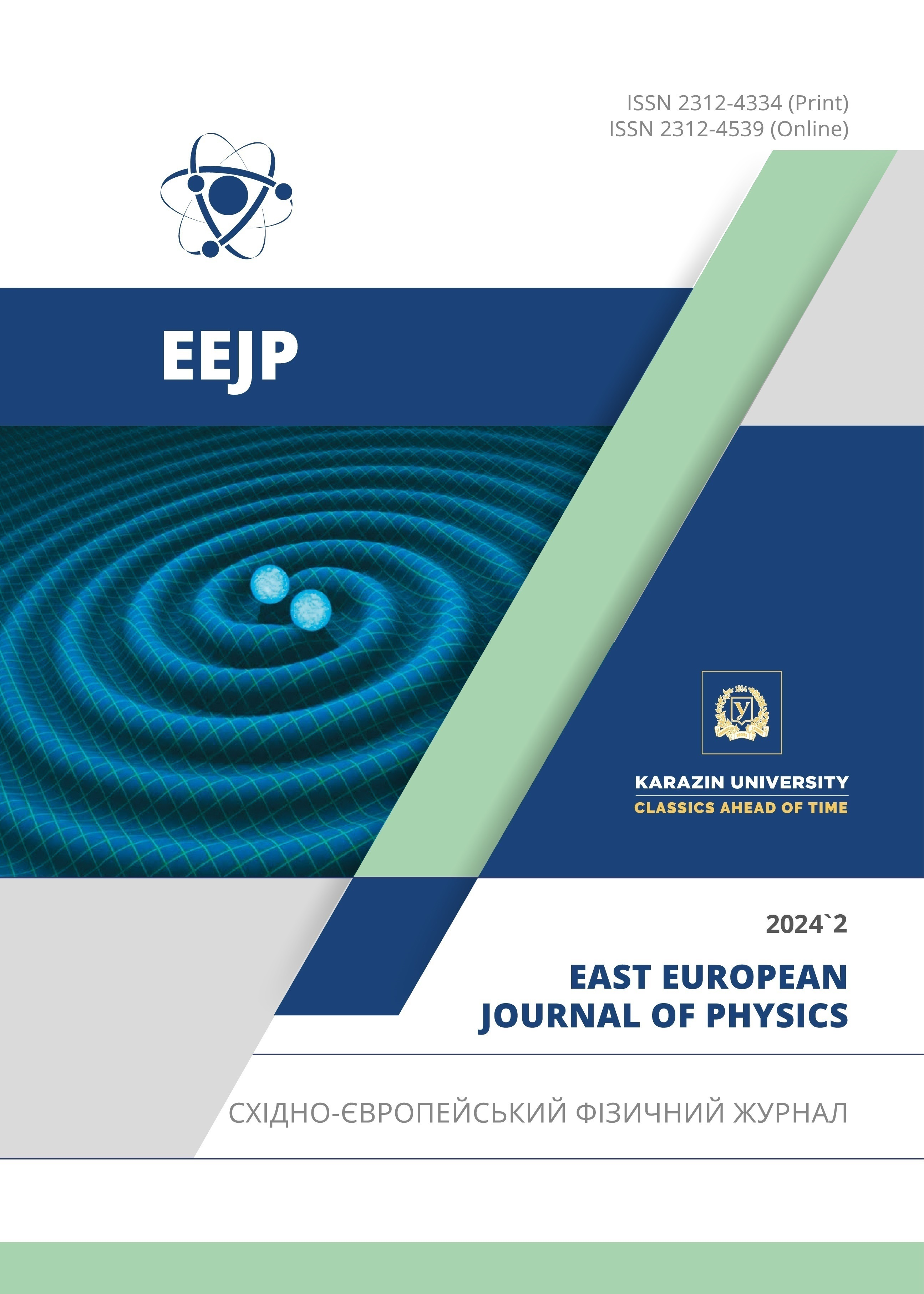Higher Overtone Vibrational Frequencies of Cyclobutane-D8 Using Lie Algebraic Framework
Abstract
This research study employs a Lie algebraic framework to investigate the second and third overtone vibrational frequencies and their combination bands in cyclobutane-d8 (C4D8). The application of this framework ensures the preservation of the point symmetry group D2d, characterized by the symmetry species A1, A2, B1, B2, and E. The analysis encompasses 23 normal vibrational modes within the molecular structure of cyclobutane-d8. Our study extensively explores the vibrational spectra, elucidating the intricate interactions among these vibrational modes. Preserving molecular symmetry allows for a deeper understanding of vibrational interactions, offering valuable insights into spectroscopy. The research enhances the comprehension of molecular structure and its applications in various fields, providing a detailed view of higher energy levels and complex vibrational transitions in cyclobutane-d8.
Downloads
References
C.W. Bauschlicher, and S.R. Langhoff, “The calculation of accurate harmonic frequencies of large molecules: the polycyclic aromatic hydrocarbons, a case study,” Spectrochim. Acta A, 53(8), 1225-1240 (1997). https://doi.org/10.1016/S1386-1425(97)00022-X
V. Špirko, and W.P. Kraemer, “Anharmonic potential function and effective geometries for the NH3 molecule,” J. Mol. Spectrosc. 133(2), 331-344 (1989). https://doi.org/10.1016/0022-2852(89)90196-3
S. Brodersen, and J.-E. Lolck, “Calculation of rotation-vibrational energies directly from an anharmonic potential function,” J. Mol. Spectrosc. 126(2), 405-426 (1987). https://doi.org/10.1016/0022-2852(87)90246-3
P.T. Panek, A.A. Hoeske, and C.R. Jacob, “On the choice of coordinates in anharmonic theoretical vibrational spectroscopy: Harmonic vs. anharmonic coupling in vibrational configuration interaction,” J. Chem. Phys. 150(5), 054107 (2019). https://doi.org/10.1063/1.5083186
E.E. Porchelvi, and S. Muthu, “Vibrational spectra, molecular structure, natural bond orbital, first-order hyperpolarizability, thermodynamic analysis and normal coordinate analysis of Salicylaldehyde p-methylphenylthiosemicarbazone by density functional method,” Spectrochim. Acta A, 134, 453-464 (2015). https://doi.org/10.1016/j.saa.2014.06.018
B. Karthikeyana, K. Sakthiraj, and P. Senthilkumar, “Investigation of Indium Trihydride Molecule and Its Clusters Using Density Functional Theory for Semiconductor Application,” Acta Phys. Pol. A, 139(1), 14-19 (2021). https://doi.org/10.12693/APhysPolA.139.14
N.e Mardirossian, and M. Head-Gordon, “Thirty years of density functional theory in computational chemistry: an overview and extensive assessment of 200 density functionals,” Mol. Phys. 115(19), 2315-2372 (2017). https://doi.org/10.1080/00268976.2017.1333644
L. Lapinski, H. Rostkowska, M.J. Nowak, J.S. Kwiatkowski, and J. Leszczyński, “Infrared spectra of thiouracils: experimental matrix isolation and ab initio Hartree-Fock, post-Hartree-Fock and density functional theory studies,” Vib. Spectrosc. 13(1), 23 40 (1996). https://doi.org/10.1016/0924-2031(96)00026-4
P. Echenique, and J.L. Alonso, “A mathematical and computational review of Hartree–Fock SCF methods in quantum chemistry,” Mol. Phys. 105(23-24), 3057-3098 (2007). https://doi.org/10.1080/00268970701757875
H. Ghalla, N. Rekik, A. Michta, B. Oujia, and H.T. Flakus, “Theoretical modeling of infrared spectra of the hydrogen and deuterium bond in aspirin crystal,” Spectrochim. Acta A, 75(1), 37-47 (2010). https://doi.org/10.1016/j.saa.2009.09.029
W. Li, Z. Ni, and S. Li, “Cluster-in-molecule local correlation method for post-Hartree–Fock calculations of large systems,” Mol. Phys. 114(9), 1447-1460 (2016). https://doi.org/10.1080/00268976.2016.1139755
R. Venkatraman, J.S. Kwiatkowski, G. Bakalarski, and J. Leszczynski, “Molecular structure and IR spectra of bromomethanes by DFT and post-Hartree-Fock MP2 and CCSD(T) calculations,” Mol. Phys. 98(6), 371-386 (2000). https://doi.org/10.1080/00268970009483302
K.B. Beć, J. Grabska, and C.W. Huck, “Current and future research directions in computer-aided near-infrared spectroscopy: A perspective,” Spectrochim. Acta A, 254, 119625 (2021). https://doi.org/10.1016/j.saa.2021.119625
F. Iachello, and R.D. Levine, Algebraic theory of molecules, (Oxford University Press, Oxford, 1995).
V. Jaliparthi, and M.R. Balla, “Vibrational Hamiltonian of Tetrachloro-, Tetrafluoro-, and Mono- Silanes Using U(2) Lie Algebras,” Spectrochim. Acta A, 264, 120289 (2022). https://doi.org/10.1016/j.saa.2021.120289
M.R. Balla, and V. Jaliparthi, “Vibrational Hamiltonian of Naphthalene (C10H8) Using Dynamical U(2) Lie Algebras,” Polycycl. Aromat. Compd. 42(7), 4684-4699 (2022). https://doi.org/10.1080/10406638.2021.1901126
S. Oss, “Algebraic models in molecular spectroscopy,” in: Advances in Chemical Physics: New Methods in Computational Quantum Mechanics, vol. 93, edited by I. Prigogine, and S.A. Rice (John Wiley & Sons, Inc. 1996). pp. 455 649. https://doi.org/10.1002/9780470141526.ch8
M.R. Balla, and V. Jaliparthi, “Vibrational Hamiltonian of Methylene Chloride Using U(2) Lie Algebra," Mol. Phys., 115, e1828634 (2021). https://doi.org/10.1080/00268976.2020.1828634
V. Jaliparthi, “Vibrational Energies of Silylene, Difluorosilylene and Dichlorosilylene, Using U(2) Lie Algebraic Model,” Ukr. J. Phys. Opt. 23(3), 126-132 (2022). https://doi.org/10.3116/16091833/23/3/126/2022
M.R. Balla, S. Venigalla, and V. Jaliparthi, “Calculation of Vibrational Frequencies of Sulfur Dioxide by Lie Algebraic Framework,” Acta Phys. Pol. A, 140(2), 138-140 (2021). https://doi.org/10.12693/APhysPolA.140.138
J. Vijayasekhar, P. Suneetha, and K. Lavanya, “Vibrational spectra of cyclobutane-d8 using symmetry-adapted one-dimensional Lie algebraic framework,” Ukr. J. Phys. Opt. 24, 193-199 (2023). https://doi.org/10.3116/16091833/24/3/193/2023
K. Nakamoto, Infrared and Raman Spectra of Inorganic and Coordination Compounds: Part A: Theory and Applications in Inorganic Chemistry, (Wiley, New York, 2009).
K.P. Huber, and G. Herzberg, Molecular Spectra and Molecular Structure. IV: Constants of Diatomic Molecules, (Van Nostrand Reinhold, New York, 1979).
Copyright (c) 2024 A. Ganapathi Rao, K. Lavanya, J. Vijayasekhar

This work is licensed under a Creative Commons Attribution 4.0 International License.
Authors who publish with this journal agree to the following terms:
- Authors retain copyright and grant the journal right of first publication with the work simultaneously licensed under a Creative Commons Attribution License that allows others to share the work with an acknowledgment of the work's authorship and initial publication in this journal.
- Authors are able to enter into separate, additional contractual arrangements for the non-exclusive distribution of the journal's published version of the work (e.g., post it to an institutional repository or publish it in a book), with an acknowledgment of its initial publication in this journal.
- Authors are permitted and encouraged to post their work online (e.g., in institutional repositories or on their website) prior to and during the submission process, as it can lead to productive exchanges, as well as earlier and greater citation of published work (See The Effect of Open Access).








